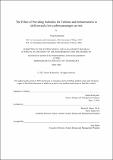The Effect of Providing Subsidies for Vehicles and Infrastructures to shift toward a low carbon passenger car mix
Author(s)
Kobayashi, Naoki
DownloadThesis PDF (5.038Mb)
Advisor
Moser, Bryan R.
Terms of use
Metadata
Show full item recordAbstract
The transportation sector in Japan in FY 2019 accounted for 18.6% of total CO2 emissions in Japan. In particular, passenger cars accounted for 8.5% of total CO2 emissions. To decrease CO2 emissions, The adoption of clean energy vehicles such as Battery Electric Vehicle (EV) and Fuel Cell Vehicle (FCV) is proposed as one effective means to reduce CO2. However, In Japan, the share of EV (0.43%) and FCV (0.04%) still remain less than 0.5% of annual sales.
To address this issue, the Government of Japan (GOJ) provides subsidies both for vehicles and infrastructure. However, no specific goal for the share of cars by type (E.g., EV, FCV) or discussions based on the systematic approach exist. The lack of whole system analysis and strategy for the long-term future can lead to non-desirable results or extra costs to realize a low carbon society in 2050.
In the past, some research has explored the relationship between EV diffusion and subsidies for EVs and infrastructure. Some carried out scenario-based mobility portfolio analyses. However, there is no research to explore a decision-making analysis that adequately considers uncertainty. Therefore, the aim of this thesis is to build a model to predict future mobility shares depending on the amount of subsidies and their duration. Then, analyzing its uncertainties and risk to design policies that more effectively reduce CO2 while meeting residential transportation demands.
This research finds that given consideration of both infrastructure and vehicle subsidies, prioritization of subsidies for EV is a more effective policy strategy than a balanced or prioritized policy for FCV for the Japanese domestic residential transportation market. In addition, subsidies for infrastructure are more cost effective compared with vehicle subsidies.
To deal with uncertainties, hydrogen station and FCV subsidies mitigate the risk of non-carbon neutral power generation. If the ratio of fossil fuel to power generation is over 31.5%, CO2 emissions of FCV main case (03_FCV full commit) are lower than that of EV main case (02_EV full commit).
It is also revealed that policies to improve fuel efficiency, such as fuel efficiency regulations for gasoline vehicles and support for technological development, can reduce the downside risk of increased CO2 emissions, but they are also not good for future CO2 emissions reduction by delaying the replacement of ICEV or HV to EV and FCV.
Finally, considering budget limits, this research finds that Japan policy for residential transportation vehicle subsidies to reduce CO2, should focus on the infrastructure at first is a good way to reduce CO2 emissions, then should go EV and avoid FCV subsidy. In the case of subsidies limitation with 50T¥, subsides for EV and infrastructure case (PF2) decrease 123[Mton] (10.2%) of CO2 emissions compared with the current policy case (01_current policy case). Then, delaying the initiation of FCV subsidy is an effective measure to decrease CO2 emission by about 0.1~0.3% if ICEV has been replaced by EV.
Date issued
2022-05Department
System Design and Management Program.Publisher
Massachusetts Institute of Technology